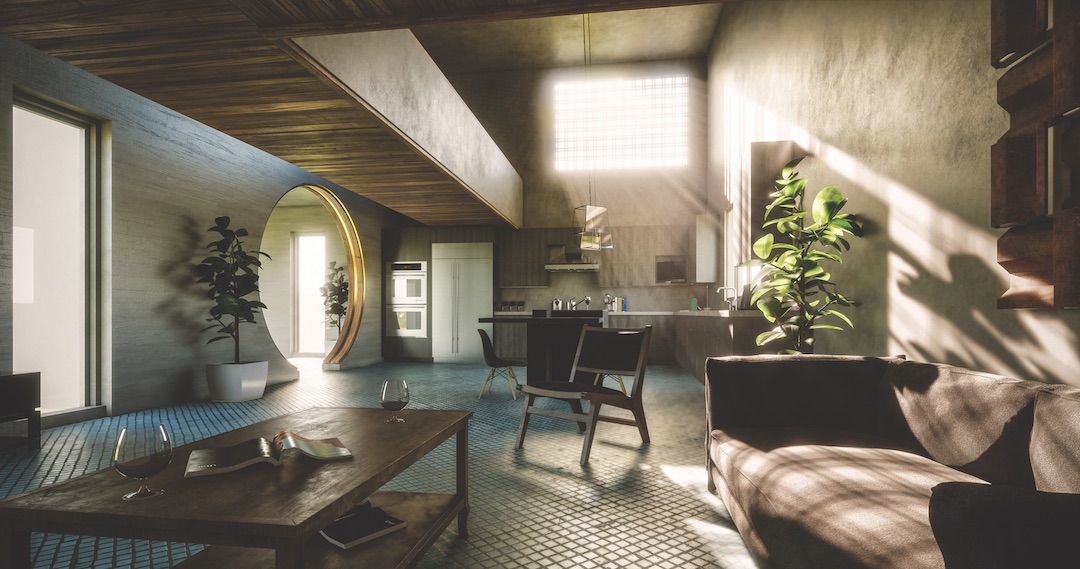During the past half-decade, a number of AEC technologies have sprung from a common, and perhaps unexpected, source: video games. From urban planning tools to the integration of VR, the well of video game inspiration springs eternal in the AEC world.
The newest tool to find a home in the kits of architects and designers has spent the last couple of decades being perfected by the video game industry: real-time rendering.
Real-time rendering, as its name would suggest, is focused on producing, altering, and analyzing images in real time. In the video game world, real-time rendering can be seen during game play; a character is controlled and the surrounding environment alters accordingly to simulate movement. A cutscene in a video game—when a player has no control—represents a more traditional, pre-rendered approach that is common in the AEC industry.
For AEC professionals, choosing real-time rendering techniques over more traditional rendering can mean the difference between making a change that is reflected instantaneously and making a change that may take a week or longer to be reflected in the project renderings. This swift turnaround can help firms save time and money and create a more streamlined experience for clients.
There are several software options: Enscape, eyecad VR, FluidRay RT, and Lumion. These tools work with programs such as SketchUp, Revit, and Rhino to enable real-time rendering and eliminate exporting modeling to another program.
With these tools, architects can make adjustments, large and small, to building plans. A designer using SketchUp with the Lumion Live Sync plug in, for example, can make necessary changes in the SketchUp model and see them reflected immediately in Lumion.
Users can move objects around, add different surface textures (e.g., polished, chrome, fabric), have lights or electronic screens emit illumination, and change sun settings. Realistic water, grass, time of day, and shadow effects can also be added and changed. In many cases, full visualizations can be created from an architectural model in 15 minutes.
Display settings can be changed for presentation purposes. Enscape’s Light View shows how much lux falls onto each surface in real time as the sun changes position throughout the day. If the date, time, and location have been selected, the sun angle will be displayed correctly.
 A before and after depicting Enscape’s real-time rendering software.
A before and after depicting Enscape’s real-time rendering software.
The single greatest benefit real-time rendering provides is better communication between an architect and a client. “It promotes active participation in design presentations and allows us to be more flexible,” says Phil Kolbo, LEED AP, Senior Architect and Associate Principal with Populous.
Traditional rendering methods require the design to be developed beforehand, so any requested changes need to be noted and executed at a later date. This means if a design team wants to present a client with three design options, four material choices, and six views, the presentation would require 72 different renderings. With real-time rendering, the design options can be changed in real time and the material options can be toggled on/off in seconds.
Orlando City Stadium, designed by Populous and opened in early 2017, is the result of this new real-time rendering approach. The 25,500-seat stadium’s seating bowl was designed in real time in front of the client group. The design team was able to test a variety of ideas as quickly as they or the client group could think of them. “As a result, the clients came to understand the site and stadium design limitations as much as we did, and we left the meeting with a greater level of trust from the clients,” says Kolbo.

Populous utilized real-time rendering tools to enhance client collaboration efforts on the 25,500-seat Orlando City Stadium.
Real-time peccadilloes
Just about any computer has the power to display traditionally rendered images without issue. But real-time rendering requires more powerful hardware, especially in the graphics department.
“Designers have to create models efficiently in order to achieve the best visual performance,” Kolbo says. “Strategies like advanced texturing and light baking can give models a life-like level of quality while still allowing them to run at a real-time level.”
Another consideration is allowing extra time for design and development. Because a client can request to see any part of a model at any time due to real-time rendering’s flexibility, all parts of the model need to be of high quality and ready to view.
“The technology behind real-time rendering software is constantly improving, but it currently calls for designers to make a choice between easy-to-use and non-customizable solutions or ones that are more complex and versatile,” says Kolbo. “Merging these points will unlock a lot more potential in the future.”
Real-time rendering still presents some trade offs when compared to traditional rendering. But as the technology advances, the benefits will begin to outweigh the limitations.
Related Stories
| Aug 11, 2010
Guggenheim and Google team up on shelter design competition
The Solomon R. Guggenheim Museum and Google yesterday announced the launch of Design It: Shelter Competition, a global, online initiative that invites the public to use Google Earth and Google SketchUp to create and submit designs for virtual 3-D shelters for a location of their choice anywhere on Earth. The competition opened on June 8, 2009, in honor of Frank Lloyd Wright’s birthday, and closes to submissions on August 23.
| Aug 11, 2010
EwingCole to merge with healthcare specialist Robert D. Lynn Associates
EwingCole, a nationally recognized architectural, engineering, interior design, and planning firm with more than 320 professionals, today announced that it will combine its practice with Robert D. Lynn Associates of Philadelphia, a 40-person firm with a robust portfolio of healthcare projects. The combination will create the Delaware Valley¹s largest and most comprehensive firm with an emphasis on healthcare architecture, and a national scope and presence.
| Aug 11, 2010
Jacobs, Arup, AECOM top BD+C's ranking of the nation's 75 largest international design firms
A ranking of the Top 75 International Design Firms based on Building Design+Construction's 2009 Giants 300 survey. For more Giants 300 rankings, visit http://www.BDCnetwork.com/Giants
| Aug 11, 2010
BIM adoption rate exceeds 80% among nation’s largest AEC firms
The nation’s largest architecture, engineering, and construction companies are on the BIM bandwagon in a big way, according to Building Design+Construction’s premier Top 170 BIM Adopters ranking, published as part of the 2009 Giants 300 survey. Of the 320 AEC firms that participated in Giants survey, 83% report having at least one BIM seat license in house, and nearly a quarter (23%) have 100-plus seats.
| Aug 11, 2010
Architecture Billings Index flat in May, according to AIA
After a slight decline in April, the Architecture Billings Index was up a tenth of a point to 42.9 in May. As a leading economic indicator of construction activity, the ABI reflects the approximate nine to twelve month lag time between architecture billings and construction spending. Any score above 50 indicates an increase in billings.
| Aug 11, 2010
Architecture Billings Index drops to lowest level since June
Another stall in the recovery for the construction industry as the Architecture Billings Index (ABI) dropped to its lowest level since June. The American Institute of Architects (AIA) reported the August ABI rating was 41.7, down slightly from 43.1 in July. This score indicates a decline in demand for design services (any score above 50 indicates an increase in billings).
| Aug 11, 2010
RTKL names Lance Josal president and CEO
Lance K. Josal FAIA has been named President and CEO of RTKL Associates Inc., the international planning, design and engineering firm. Josal succeeds RTKL’s current President and CEO, David C. Hudson AIA, who is retiring from the firm. The changes will take effect on 1 September 2009.
| Aug 11, 2010
Billings at U.S. architecture firms exceeds $40 billion annually
In the three-year period leading up to the current recession, gross billings at U.S. architecture firms increased nearly $16 billion from 2005 and totaled $44.3 billion in 2008. This equates to 54 percent growth over the three-year period with annual growth of about 16 percent. These findings are from the American Institute of Architects (AIA) Business of Architecture: AIA Survey Report on Firm Characteristics.
| Aug 11, 2010
Potomac Valley Brick launches brick design competition with $10,000 grand prize
Potomac Valley Brick presents Brick-stainable: Re-Thinking Brick a design competition seeking integrative solutions for a building using clay masonry units (brick) as a primary material.
| Aug 11, 2010
HDR, Perkins+Will top BD+C's ranking of the nation's 100 largest healthcare design firms
A ranking of the Top 100 Healthcare Design Firms based on Building Design+Construction's 2009 Giants 300 survey. For more Giants 300 rankings, visit http://www.BDCnetwork.com/Giants







